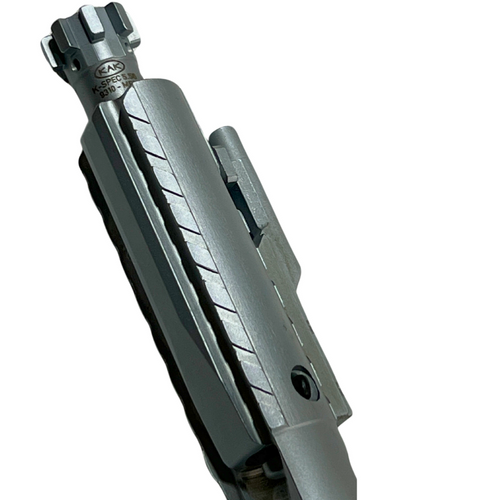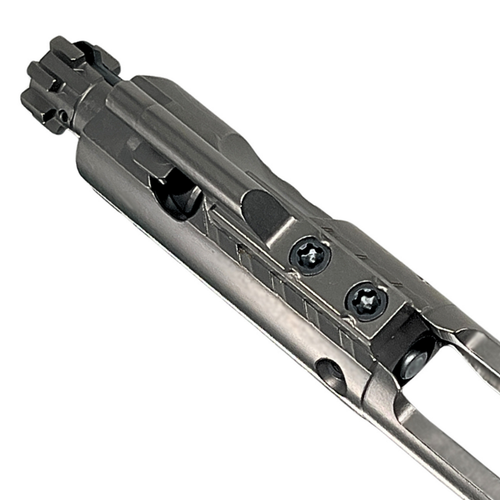*CONTACT US FOR A SPECIAL COUPON CODE!*
The K-SPEC BCG combines multiple key features focused on increasing the reliability of your AR15 style firearm no matter if you are running suppressed or unsuppressed, and regardless of conditions. The K-SPEC is a truly plug and play BCG that will accommodate whatever configuration your mission requires.
For those running suppressed, the K-SPEC requires no additional tuning or tweaking of the gas or recoil systems to run reliably. Like all KAK BCGs, the K-SPEC is machined to the M16 full auto profile.
Reduced Peak DB Report
When used in conjunction with a silencer, the gas redirect produces a quieter report
See testing results here- Down Vent vs Side Vent DB reduction testing
Slotted Angled Carrier Rails
For enhanced functionality in adverse and rugged conditions such as sand, mud, dirt, and grime. These rail cuts are designed for debris disbursement, resulting in ultra-high functionality in the toughest conditions, including suppressor fouling and foreign contaminates. Strategically located angle cuts in the rails result in fouling and debris being moved into noncritical areas that are not in contact with the receiver and do not affect the function of the firearm. aka sandcutter
Downward Gas Vents
In an effort to reduce the amount of debris and gas vented towards the shooters face, the two standard gas relief ports have been relocated from the ejection port side of the K-SPEC carrier and placed underneath, in the magazine feed lip channels. Two additional emergency relief ports have also been added to the bottom of the carrier to mitigate structural damage in the event of a case head separation. Testing has shown that venting the gasses through the magazine well has no negative impact on the feeding or function of the magazine nor ammunition, and any added heat is negligible.
Dual ejectors
The K-SPEC dual ejector system uses mil-spec ejectors and springs that require no proprietary parts. Ejector holes are centered on the lugs to avoid any reduction in strength of the bolt. The dual ejector system increases the ejection reliability and adds consistency to the ejection pattern. KAK Industry has been manufacturing dual ejector bolts for the AR10/LR308 platform for over a decade and has used that experience to create a durable and reliable dual ejector system for the AR15 platform.
- Designed to function reliably in the toughest conditions
- Optimized for both Suppressed and Un-suppressed use, All uses – All Conditions
- Dual Ejectors for enhanced reliability
- Angled Carrier Rail Cuts for flawless function in adverse conditions and prolonged suppressed use
- Downward Gas Ports to reduce gas blowback to shooter
- Full Auto Profile
- Permatex added between Gas Key and Carrier Mating Surface
- Carrier- 8620 steel, outside rails, bolt runs, and gas bores ground to .0002 tolerances, FDE PVD finish
- Bolt- 9310 steel, outside diameters ground to .0002 tolerances, MPI test, FDE PVD finish
- Firing Pin- 8740 steel, Swiss turned, heat treated, precision ground, chrome plated
- Cam Pin – 4140 steel, Swiss turned, heat treated, FDE PVD finish, Chrome Lined
- Extractor- 4140 steel, fully machined, Phosphate coated
- Extractor pin- S7 tool steel, ground, heat treated
- Ejector- S7 tool steel, ground, heat treated
- Gas key – 4130 steel, heat treated, FDE PVD finish, secured with T25 torx fasteners, torqued to spec, staked with hydraulic staking machine, FDE PVD finish
- 11.5 oz
Machined in house and assembled using only the finest steels and components.
KAK Industry takes pride in producing some of the finest Mil-Spec/ Enhanced AR15 bolt carrier groups available, made 100% in house at our MO facility using Doosan machining centers, Tsugami Swiss turning, and the latest in FANUC robotics combined into an automated cell giving us lights out production capability. In house automated CMM Inspection processes ensure consistent quality.
PVD (Physical Vapor Deposition) coating is a process used to apply thin films or coatings to surfaces, offering a range of benefits depending on the material and application. PVD is widely used in various industries, including aerospace, firearms, and manufacturing, due to its ability to improve surface properties such as hardness, corrosion resistance, and aesthetic appearance.
How PVD Works
- Vaporization: A material (typically a metal or metal compound) is vaporized in a vacuum chamber. This can be done using techniques like sputtering or evaporation.
- Deposition: The vaporized material then condenses onto the substrate (the surface being coated) to form a thin, solid film.
- Bonding: The coating adheres to the substrate surface, forming a durable layer.
Benefits of PVD Coatings
- Durability: PVD coatings are known for their hardness and wear resistance, which makes them ideal for applications where surfaces are subject to friction or abrasion.
- Corrosion Resistance: They provide excellent protection against corrosion, extending the lifespan of the coated materials.























